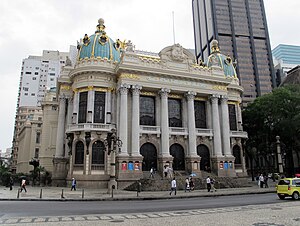Teatro Municipal (Rio de Janeiro)
| Rio de Janeiro Municipal Theatre | |
|---|---|
| Theatro Municipal do Rio de Janeiro | |

Municipal Theatre of Rio de Janeiro: frontal view.
|
|
| Alternative names | Municipal |
| General information | |
| Type | Opera house |
| Architectural style | Eclectic and Art Nouveau |
| Location | Praça Floriano, S/N, Centro, Rio de Janeiro |
| Construction started | 1905 |
| Completed | 1909 |
| Inaugurated | 14 July 1909 |
| Design and construction | |
| Architect | Francisco de Oliveira Passos |
| Other information | |
| Seating capacity | 2244 |
Coordinates: 22°54′33.20″S 43°10′35.37″W / 22.9092222°S 43.1764917°W
The Municipal Theatre (Portuguese: Theatro Municipal) is located in Cinelândia (Praça Marechal Floriano) in the city center of Rio de Janeiro, Brazil. Built in the beginning of the twentieth century, it is considered to be one of the most beautiful and important theatres in the country.
The building is designed in an eclectic style, inspired by the Paris Opéra of Charles Garnier. The outside walls are inscribed with the names of classic Eurocentric & Brazilian artists. It is located near the National Library and the National Fine Arts Museum, overlooking the spacious Cinelândia Square.
In the second half of nineteenth century, theatrical activity was very intense in Rio de Janeiro, then capital of the country. Still, its two theaters, the Lyric and St. Peter, were criticized for their facilities, either by the public or by the companies that worked in them.
After the Proclamation of the Republic (1889), in 1894 playwright Arthur Azevedo launched a campaign for the building of a new theater to host a local company, to be created along the lines of the Comédie Française. However, in those hectic days, the campaign resulted in only one Municipal Law, which ordered the construction of the Municipal Theater. This law was not enforced, despite the existence of a levy to finance the work. Thus, that the new tax revenue was never used for the construction of the theater.
...
Wikipedia
